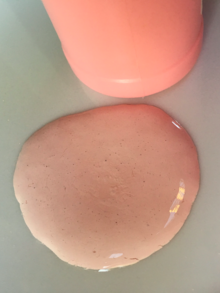
Back كالامين Arabic Calamina Catalan Calamine (Stoffgemisch) German Calamina Spanish کالامین دی Persian Calamine (mélange) French Cailmín Irish קלמין HE कैलेमाइन Hindi Կալամին (դեղ) Armenian
 A puddle of calamine lotion next to a pink plastic bottle | |
| Combination of | |
|---|---|
| zinc oxide | astringent |
| ferric oxide | antipruritic |
| Clinical data | |
| Pronunciation | KAL-ə-mine[1] |
| Other names | Calamine lotion |
| License data | |
| Routes of administration | Topical |
| ATC code | |
| Legal status | |
| Legal status |
|
| Identifiers | |
| CAS Number | |
| PubChem CID | |
| ChemSpider | |
| KEGG | |
| ChEMBL | |
| Chemical and physical data | |
| 3D model (JSmol) | |
| |
| |
Calamine, also known as calamine lotion, is a medication made from powdered calamine mineral that is used to treat mild itchiness.[2][3] Conditions treated include sunburn, insect bites, poison ivy, poison oak, and other mild skin conditions.[4][5] It may also help dry out secretions resulting from skin irritation.[1] It is applied on the skin as a cream or lotion.[2]
Side effects may include skin irritation.[4] It is considered to be safe in pregnancy.[4] Calamine is a combination of zinc oxide and 0.5% ferric oxide (Fe2O3).[6] The lotion is produced with additional ingredients such as phenol and calcium hydroxide.[6][7]
The use of calamine lotion dates back as far as 1500 BC.[8] It is on the World Health Organization's List of Essential Medicines.[9] Calamine is available over-the-counter as a generic medication.[5]
- ^ a b "Calamine (topical) medical facts from Drugs.com". www.drugs.com. Archived from the original on 2017-11-07.
- ^ a b British National Formulary: BNF 69 (69 ed.). British Medical Association. 2015. p. 801. ISBN 9780857111562.
- ^ World Health Organization (2009). Stuart MC, Kouimtzi M, Hill SR (eds.). WHO Model Formulary 2008. World Health Organization. p. 303. hdl:10665/44053. ISBN 9789241547659.
- ^ a b c "Aqueous Calamine Cream BP - Summary of Product Characteristics (SPC) - (eMC)". www.medicines.org.uk. 18 November 2016. Archived from the original on 30 December 2016. Retrieved 29 December 2016.
- ^ a b Hamilton R (2015). Tarascon Pocket Pharmacopoeia 2015 Deluxe Lab-Coat Edition. Jones & Bartlett Learning. p. 191. ISBN 9781284057560.
- ^ a b Braun-Falco O, Plewig G, Wolff HH, Burgdorf W (2012). "Topical Therapy". Dermatology (2nd ed.). Springer Science & Business Media. p. 1724. ISBN 9783642979316. Archived from the original on 2016-12-29.
- ^ Ma JK, Hadzija B (2012). "Rheology in Pharmacy". Basic Physical Pharmacy. Jones & Bartlett Publishers. p. 327. ISBN 9780763757342. Archived from the original on 2016-12-30.
- ^ Darnton-Hill I, Ahmed F, Samman S (2016). "The impact of micronutrients on inflammation and health in low-and middle-income countries.". In Bendich A, Deckelbaum RJ (eds.). Preventive Nutrition: The Comprehensive Guide for Health Professionals (5th ed.). Springer. pp. 597-644 (608). ISBN 9783319224312. Archived from the original on 2016-12-30.
- ^ World Health Organization (2019). World Health Organization model list of essential medicines: 21st list 2019. Geneva: World Health Organization. hdl:10665/325771. WHO/MVP/EMP/IAU/2019.06. License: CC BY-NC-SA 3.0 IGO.